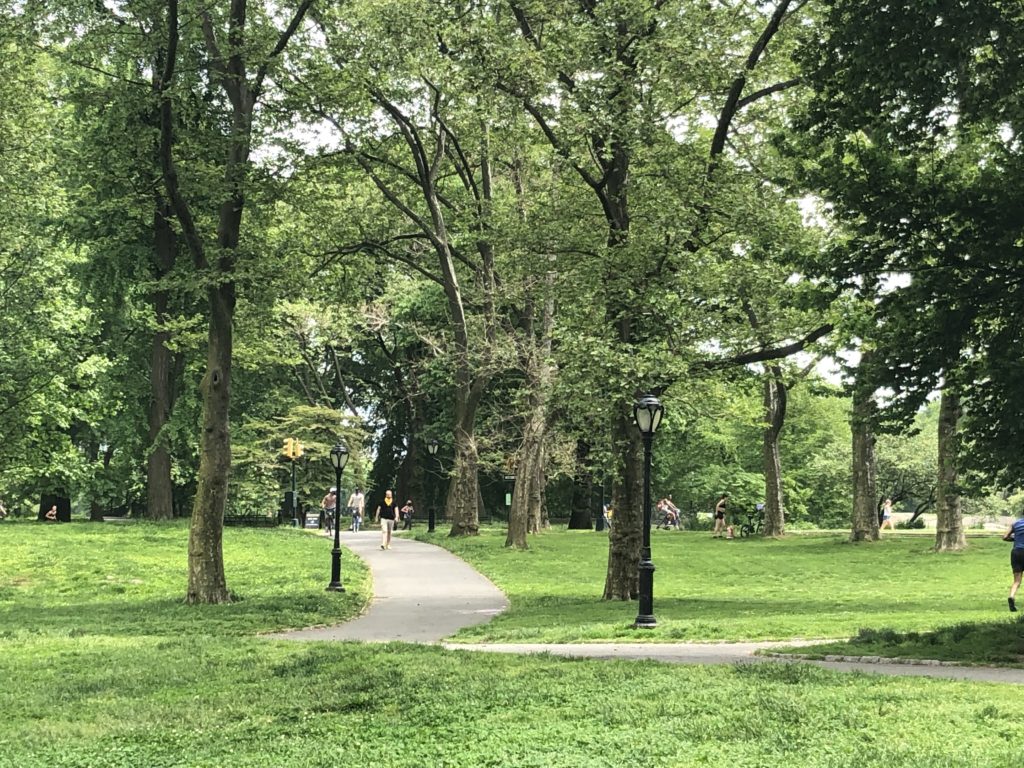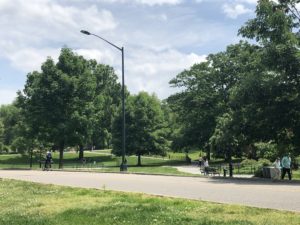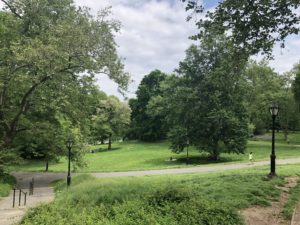News
Going outside or staying indoors? How this choice impacts individual well-being

SRN-affiliated researchers have received NSF RAPID funding to study this question, using multiple methods to understand the complex relationships between subjective well-being, green space access, and perceived risk
A team of SRN-affiliated researchers at Columbia University, and their colleagues at Barnard College, have received funding through the NSF RAPID program to expand their research on well-being and green space. As states began mandating social distancing or issuing stay-at-home orders in mid-March, 2020, residents were instructed to stay indoors whenever possible, avoiding contact with people and going outside only for exercise and essential errands. At the same time, this team began wondering—what impact was this necessary directive having on individuals’ subjective well-being?
Utilizing NSF’s Rapid Research Response funding mechanism, which allows for the swift approval of grants in response to disasters and similarly fast-moving events, researchers at Columbia University and Barnard College have designed a study to explore the connections among green space, perception of risk, and well-being in times of a public health emergency that require people to stay indoors and isolated (grant #2029301). Numerous studies, including research by SRN affiliates, have shown that exposure to green spaces has a positive impact on the well-being of city residents. While risk of COVID-19 infection is a very real concern, and social distancing an appropriate response, how do these necessary measures affect individuals’ subjective well-being? Do people in different locations—some with access to a private yard, others with only a neighborhood park to walk to, others who have no green space they can access at all—experience different impacts to their well-being? And what role does the perceived risk of going outdoors during the COVID-19 pandemic play in the associations between green space access and well-being?

This study combines online surveys conducted during the height of quarantine measures in the US with follow-up video interviews. Researchers are conducting this research with college students, as these students have traveled home from their campuses, returning to a wide variety of residential and landscape forms. This gives researchers the ability to conduct comparative study of how access to green space influences responses to current conditions and well-being. The survey, distributed via email, includes questions about well-being, outdoor activity, risk perception, and personal responses to social distancing measures. Interviewees, solicited from survey participants, are asked questions about available outdoor green space and activity, lifestyle changes in response to COVID-19 and their effect on well-being, the role of outdoor activity in subjects’ well-being, and barriers to outdoor activity under present circumstances. Both statistical analyses and qualitative coding analyses will be used to determine (a) subjects’ access to different types of green space; (b) subjects’ willingness to utilize green space with respect to type, accessibility, and risk perception; and (c) the association of (a) and (b) with subjects’ well-being during the pandemic.
As of this writing, the survey portion of the study has been completed, with 1000 surveys submitted between April 15 and May 15, 2020. Interviews with participants are ongoing, and analysis of survey data is beginning. Preliminary results suggest that going outdoors has a positive effect on well-being. On a scale of 1–10, participants’ mean well-being at time of survey was 6.3 (SD=1.8), their overall well-being was 7.3 (SD=1.7), and their well-being during their most recent trip outdoors was 7.9 (SD=1.6). Respondents were making an average of 4.9 trips outdoors per week (SD=1.5), with the four most common destinations being their neighborhood (28.5%), a public park or garden (17.4%), a store (15.3%), and a private yard or garden (14.6%). When asked to rate how risky they perceived going outdoors to be, only 3.4% chose “very risky, people should not go outside,” while 27.2% considered it “risky, people should limit their time outdoors.” Half of respondents selected “somewhat risky,” and 19.4% chose “not risky at all.”

The research team is currently cleaning the survey data in preparation for a range of statistical analyses. Interviews are scheduled to continue through June, with transcription and coding set to follow. When analyses are complete, we plan to publish our results in a series of research papers, and also hope to be able to inform current and future preparations and responses to pandemics and other extreme emergency circumstances through recommendations on outdoor recreation, well-being, and current and future planned GI design.
Project Personnel: Megan Maurer (Columbia University, SRN affiliate), Elizabeth Cook (Barnard College), Patricia Culligan (Columbia University, SRN affiliate), Brian Mailloux (Barnard College), Ben Orlove (Columbia University, SRN affiliate), and Liv Yoon (Columbia University).




